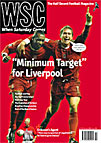 For Steve Wilson, the gleaming seats and award-winning arches of the McAlpine Stadium cannot replace the pleasures of standing behind the goal at Leeds Road under a rickety iron roof
For Steve Wilson, the gleaming seats and award-winning arches of the McAlpine Stadium cannot replace the pleasures of standing behind the goal at Leeds Road under a rickety iron roof
I can hear the words before they’re formed. Someone new asks me which team I follow. “Huddersfield Town,” I reply, then wait. A slightly blank look appears on their face, mixing surprise, confusion and pity. And then it comes: “Nice stadium.”
It doesn’t bother me that this is all that many football fans know about our club, that they know where we play rather than who we are, that nearly a century of history boils down to these two well intentioned words. No, it bothers me because they’re right. We do have a nice stadium, but we used to have a football ground.
Leeds Road was typically run-down. The seated wooden Main Stand ran along one length of the pitch facing the East (Popular) Terrace and, behind the goal at the Kilner Bank end, an open terrace was reserved for away fans to properly enjoy the Yorkshire winters. But the smallest and most distinctive stand was to be found next to Leeds Road itself, The Cowshed. So called because of the barrel-shaped iron roof above the terrace, threatening to crumble and fall for as long as I stood underneath it and probably before, The Cowshed was the beating heart of the ground on matchdays.
Despite rarely being full, the sound felt deafening. The less unruly East Terrace appeared only roused by incidents of importance on the pitch. But behind the goal we made our own entertainment. From touchline to six-yard box the opposition goalkeeper would be roundly applauded as he took up position. Mistakenly sensing unexpected respect, he would raise a gloved hand to acknowledge the gesture. This was the cue for The Cowshed to turn on him, mocking him for falling for the routine. When your team plays in the lower reaches of the league and shows little sign of wanting to move up, you make your own fun.
In a shiny new stadium, with thousands of empty seats and clear views, the inept displays are all too stark and it’s easy to be swept along on a tide of gloom. At Leeds Road, though, you could more easily huddle with like-minded souls. The fencing meant you couldn’t quite see how badly the team were playing. And the simple act of jumping up and down, as any four-year-old child will tell you, makes things seem better.
On a balmy evening in May 1992 over 16,000 crammed into the ground for the Third Division play-off semi-final against Peterborough. With a draw secured in the away leg, expectation was high. The Cowshed was heaving, hot, sticky and cramped, but no one cared; it was how it was supposed to be. Children were hoisted overhead and passed down to the front to sit on the wall – something I previously only thought happened on The Kop in the 1970s.
An early goal sparked wild celebrations. When they had subsided (a little) I caught sight of a friend sat in the Main Stand, his penance for underestimating the rush for tickets. He was smiling but not, it seemed, as much as those around me. Later he told me that he had been admonished for jumping up and down on his seat and celebrating too wildly. In The Cowshed you couldn’t go wild enough.
The evening ended sourly as the game, our trip to Wembley and some pride were all lost, 30 arrests being made following trouble at the end of the match. But the outpouring of joy that followed that first goal I remember every time I pass the B&Q superstore that stands where I once did.
Leeds Road did have its moments of fame. An England international, on a Wednesday afternoon in 1946 as absenteeism hit epidemic proportions. More recently, BBC2’s Standing Room Only chose footage of Iain Dunn burying a screamer into the back of the net nearest to where I once stood for its opening credits. Why, I don’t know, but I never missed the start.
Some friends and I grew up in The Cowshed. Yet when we played our final game at the old ground, slow in buying our tickets for a sell-out, we were forced to stand on the East Terrace. From there we could see the skeleton of the McAlpine rising in the near distance but also, for one last time, The Cowshed was full and for 90 minutes the place looked like it was supposed to. Decrepit and decaying, but the home of my modest dreams.
From WSC 204 February 2004. What was happening this month